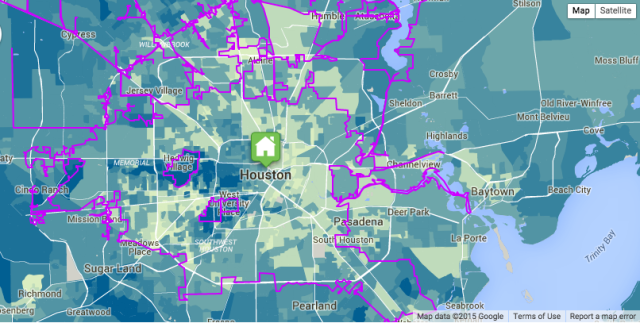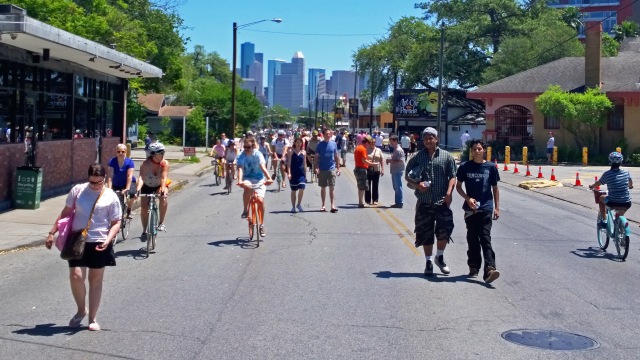In the upcoming elections, with early voting beginning October 19 and the big day itself November 3, Houstonians will be electing a new mayor and city council and deciding on several propositions. Cite asked mayoral and at-large council candidates who had announced their campaigns by July 17, 2015, to respond to this form questionnaire, which focuses on Houston’s built and natural environments. The questions were developed in consultation with experts by a steering committee: Raj Mankad, Editor, Cite; Rachel Powers, Executive Director, Citizens’ Environmental Coalition; Jen Powis, Environmental Attorney, The Powis Firm, PLLC; and Teresa Demchak, Attorney and Retired Managing Partner, Goldstein, Demchak, Borgen & Dardarian.
Two mayoral candidates, Sylvester Turner and Adrian Garcia, and 10 at-large city council candidates (Lane Lewis, Tom McCasland and Chris Oliver, Position 1; David Robinson and Andew Burkes, Position 2; Doug Peterson, Position 3; Larry Blackmon, Amanda Edwards, and Laurie Robinson, Position 4; and Phillippe Nassif, Position 5) responded to the questionnaire. These candidates’ full answers are available here and in this compilation organized by question. Below is a summary and highlights of the responses. In the coming weeks leading up to Election Day and the subsequent likely runoff races, OffCite will follow up with more analyses of the responses on key topics. You can click to jump directly to read about mobility and streets; parks, libraries, and community centers; affordability, preservation, and urban development; environment; and community engagement.
The differences among many candidates are not easy to encapsulate. An exception is the race for At-Large City Council Position 1 between incumbent David Robinson and challenger Andrew Burkes. In 2013, Robinson, an architect, defeated then-incumbent Burkes, a businessman, who is running to retake the seat. Robinson is a strong proponent of Plan Houston and general planning. By contrast, Burkes consistently argues for district-level planning.
Below, the background information that accompanied the questions is followed by a summary of the candidates' responses. Because of space limitations, this summary is not complete and the reader is encouraged to review the candidates’ complete responses to the entire questionnaire.
Background: Mobility and Streets
Improvements to bicycling infrastructure include the ongoing work on the Bayou Greenways Initiative, trails along Buffalo Bayou, and the dedicated lane along Lamar Street from Buffalo Bayou to Discovery Green. But the number of car collisions with cyclists and pedestrians, many of them fatal, is alarming.
Participants in Rice University’s 2015 Kinder Institute Houston Area Survey identified traffic as the biggest problem facing people in the Houston area today and public transit as the best long-term solution. METRO has added three new light rail lines and reimagined the bus network, but for those who wish to take transit and the over one-third of Houston’s residents who do not own or drive cars, more is needed.
The City’s approach to parking has been one-size-fits-all for most areas outside Downtown. Parking Management Districts (e.g., plans specific to the needs of one area) allow some variation, but that strategy has not been used extensively and parking remains a flashpoint in neighborhoods and an impediment for those creating transit-oriented development and small-business entrepreneurs.
City Council recently passed two ordinances making it easier for homeowners to repair sidewalks; however, low-income residents, who often live in neighborhoods with the least sidewalks, are expected to build and maintain the sidewalks in front of their property. Moreover, there is a considerable backlog of requests from disabled Houstonians to improve the conditions around their residences.
In November 2013, Mayor Parker issued an Executive Order to develop a Complete Streets and Transportation Plan. Work is underway on the Public Works and Engineering Design Manual, Regional Mobility Studies, and the Major Thoroughfare Plan. However, the City does not yet have a Complete Streets and Transportation Plan or the funding or staff to complete one.
Candidates: Mobility and Streets
Mayoral candidates Sylvester Turner and Adrian Garcia both strongly support a multi-modal transportation network with a shift from car-dependency to a more robust transit system, as do most of the at-large city council candidates. The candidates emphasize different modes, however. For example, David Robinson supports building the “University” light rail, the Bicycle Master Plan, and the Greenways Initiative, while Andrew Burkes focuses on street repair. Tom McCasland, who worked on the ParksByYou bond that is funding the Bayou Greenways Initiative, gave this response:
"I have lived without a car in Houston for two years, so I know first hand the indignities suffered by people who choose not to drive or who cannot drive for physical or economic reasons. In order to create a truly urban environment, the city needs to ensure that mobility, regardless of the mode, is safe, interesting, comfortable and useful. For vehicular traffic, I would like to see more focus on creating continuous movement of cars at a safe speed using roundabouts, light signal synchronization, and grade separation." - Tom McCasland, At-Large Position 1 Candidate.
The responses regarding Complete Streets ranged from strong support for better implementation across the city to non-committal answers. Sylvester Turner writes:
"The Complete Streets concept is an important shift for the city in terms of establishing a new standard for transportation development. The main obstacle to the effective implementation of Complete Streets is funding. Public-private partnerships are solutions for a few neighborhoods but relying exclusively on the market leaves other Houston communities behind. We need to bring all stakeholders to the table, including investors and residents, to develop an equitable solution for funding these improvements throughout the city. - Sylvester Turner, Mayoral Candidate.
All the candidates advocate for safer and more sidewalks and many gave specific examples of new funding methods to pay for this work, including: developer incentives (Adrian Garcia), Tax Increment Reinvestment Zones (TIRZs) and management districts (Lane Lewis, Doug Peterson, Laurie Robinson), revising Rebuild Houston (Lane Lewis, David Robinson), matching grants (David Robinson), Neighborhood Greenways (Tom McCasland), waiving permitting fees (Doug Peterson), and bonds (Amanda Edwards, Lane Lewis).
Many of the candidates favor rewriting parking regulations. For example, Mayoral Candidate Sylvester Turner writes, “Our current parking standards were developed for the Houston of yesterday.” His opponent, Adrian Garcia, writes:
"Establishing optimal parking requirements is one area where it is essential to utilize a holistic approach that incorporates economic development, environmental and mobility concerns, and community engagement. We need to get all the stakeholders to the table and balance residential neighborhood concerns against commercial feasibility to determine the appropriate parking requirements. I am sensitive to parking concerns in neighborhoods, but I also recognize that parking requirement exemptions may be necessary to stimulate small business growth in certain areas targeted for enhanced walkable urbanism. This process will be a give and take. - Adrian Garcia, Mayoral Candidate.
This idea of “give and take” is repeated in many of the candidates’ responses. Chris Oliver (At-Large 1) writes that we should "take parking on a community-by-community basis." Tom McCasland (At-Large 1) calls for the City to “allow the free market to determine how much parking a particular business needs” while “[e]nsuring proper protections for residential areas.”
Conversely, Andrew Burkes (At-Large 2 Candidate) writes, “Change and eliminate our permitting and fee policies. This will free businesses to expand and have more money to address the parking problems in our communities. As a business person I want my patrons to park near my business rather than far away.”
 Houston 2015 Parkscore. Orange shows areas with no access to parks. Red shows areas of serious concern. Source: parkscore.tpl.org.
Houston 2015 Parkscore. Orange shows areas with no access to parks. Red shows areas of serious concern. Source: parkscore.tpl.org.
Background: Parks, Libraries, and Community Centers
The Trust for Public Land’s 2015 ParkScore Report ranked Houston 58 out of 75 U.S. cities surveyed in meeting its need for parks. Many Houston neighborhoods do not have safe playgrounds, green spaces, or community centers that provide after-school and weekend activities for children
and teens.
While limited by a decade-old, voter-approved revenue cap, the City faces enormous infrastructure needs and mounting pension commitments. Dedicated funds from water fees are intended to address drainage, sewage, and road conditions, but other important forms of infrastructure must share dwindling general funds. The City has relied extensively on TIRZs and Management Districts to improve parks, though this strategy has been subject to criticism for a perceived lack of transparency, accountability, and comprehensiveness.
Recent floods have raised major concerns with stormwater---the water running off the built environment. Efforts to prevent flooding offer a special opportunity to achieve several goals at once: more greenspace, better habitat for wildlife, better street designs, and flood mitigation itself. Though the Flood Control District manages the bayou system, the City plays a key role in its regulation of new development and the rebuilding of streets.
Candidates: Parks, Libraries, and Community Centers
When asked, “How should the City fund improvements to and excellence in parks, libraries, and other public buildings?” the responses revealed one of the few sharp contrasts between mayoral candidates Sylvester Turner and Adrian Garcia. Turner notes that, as Vice Chair of the Texas House Appropriations Committee, he was able to get state funds dedicated to projects like the Buffalo Soldiers Museum, the Houston African-American Museum, and Emancipation Park. Turner also raises the possibility of “a voluntary contribution program, where residents designate up to a certain amount from their property tax contribution to support specific projects.” Finally he calls on the city to redouble its efforts to fundraise from private sources.
In contrast, Garcia writes:
This is a great example of why proper management of our city finances is so crucial. The absence of sustainable pension commitments leads to a structurally unbalanced budget, which strangles resources from parks, libraries and community centers. Revenue gaps also stall the process of effectively planning for a built environment that ensures sufficient long term access to quality public facilities. Apart from implementing systems to insure that we can do more with our tax dollars, I will also explore the financial barriers within management districts, such as revenue thresholds, that prevent improvement projects from promptly breaking ground. - Adrian Garcia, Mayoral Candidate.
In a mayoral race where the two purportedly leading candidates seem to agree on the big issues, the question of pension obligations---and the related availability of general funds for parks, libraries, community centers, and other purposes---is a substantive point of contention.
The at-large council candidates focus on other strategies to improve and create public amenities, including further public-private partnerships (Philippe Nassif), use of TIRZ funds (Lane Lewis), reform of the open space ordinance (Tom McCasland), securing grants (Chris Oliver), partnering with HISD (David Robinson), sharing funds and resources with Harris County as was done at the Freeman Library in Clear Lake (Doug Peterson), and tax-exempt bonds when market conditions are favorable (Amanda Edwards).
Background: Affordability, Preservation, and Urban Development
This map from the Center for Neighborhood Technology (CNT) shows that when both transportation and housing costs are considered, Houston does not appear as affordable as we tend to believe it to be.
Houston homes are becoming considerably less affordable, for both renters and homeowners. A recent Zillow survey found Houston had the 8th largest year-over-year price jump in rents, at 5.9 percent, with median rents at $1,497. Houston home values grew 12.3 percent in 2014 to a median home value of $152,600.
Without strong land use controls, the City relies on incentives to encourage development. For example, the Downtown Living Initiative gives developers up to $15,000 in tax rebates per unit for homes and multifamily projects within the Downtown District up to a total of 5,000 units. The incentives do not require the dedication of any portion of the units for affordable housing.
The options to expand affordable housing are many: developer incentives that require that a proportion of units are affordable, better leveraging of federal housing funds, use of state and local bond and development incentives (e.g., TIRZ, 380 agreements), Limited Equity Corporations, land banking, establishing ordinances for tiny houses, and incentivizing the rehabilitation of 1970s apartments that serve as de facto public housing.
Related to affordability is the preservation of existing building stock, scale, and character. The Houston Archaeological and Historical Commission and the Houston Planning and Development Department often have different interests and perspectives on issues such as issuance of certificates of appropriateness and expansion of historic districts and the ease/difficulty of their formation.
Candidates: Affordability, Preservation, and Urban Development
Affordable housing was identified by a large number of the candidates as a top priority. Many support the use of incentives (Adrian Garcia, Sylvester Turner, Andrew Burkes, Chris Oliver), TIRZs (Adrian Garcia, Amanda Edwards, Chris Oliver, David Robinson), Community Development Corporations (CDCs), public-private partnerships (Tom McCasland, David Robinson), and the General Plan (Doug Peterson) to address the need for increased affordable housing throughout the City of Houston. Larry Blackmon suggests the use of "vacant parking lots no longer utilized or effective to commercial areas anymore."
Amanda Edwards, a lawyer with a background in public finance, writes:
With an influx of attention and people descending upon the City of Houston, the housing market has seen an increase in demand in market rate housing, which our current supply cannot match. We must find innovative ways to keep up with these demands, while still providing quality affordable housing. Initiatives like promoting mixed-income development, the effective utilization of 380 agreements, and utilization of TIRZ affordable housing programs will go a long way in solving this critical issue. We must also utilize the affordable housing dollars made available by the U.S. Dept. of Housing and Urban Development. - Amanda Edwards, At-Large 4 Candidate.
The respondents gave nuanced answers in responding to questions regarding where affordable housing—especially units that receive federal funding and are designated for low-income people—should be located. OffCite will address this issue and the candidates’ responses in a subsequent, more in-depth piece. At least one candidate acknowledged that this year, in a case originating out of Dallas, the U.S. Supreme Court extended the “disparate impact” theory of liability for discrimination to the federal Fair Housing Act and ruled that, under certain circumstances, private developers and governmental entities may be liable for unlawful discrimination where their policies or practices result in segregated housing patterns regardless of whether these entities intended the discriminatory result. Mayoral candidate Sylvester Turner writes, “The recent Supreme Court ruling on affordable housing will have major impacts on development siting, with the result being a greater number of economically-mixed neighborhoods. This mode of housing integration has demonstrated benefits, but it may also have unintended consequences, including disinvestment in established lower-income neighborhoods.”
Chris Oliver writes, "As HCC Trustee I have seen the enormous difference that bringing community cornerstones like schools, businesses, and venues can have on a neighborhood, and I think that by encouraging further development into underdeveloped communities we can also help keep housing affordable. I will also look to utilize measures like 380 agreements and federal dollars to help develop more affordable housing across the City."
Tom McCasland, who ran the Harris County Housing Authority immediately prior to running full-time for office, writes, "The city is also long overdue for a conversation about how Section 8/housing choice vouchers are concentrated in low income, high crime neighborhoods with failing public schools." Again, we will come back to this issue in the future.
Finally, when asked about balancing economic development and historic preservation interests, the candidates, for the most part, simply affirmed that, “yes,” balance is important.
 Distribution of Environmental Hazards and Race in Houston. Source: Texas Low Income Housing Information Service
Distribution of Environmental Hazards and Race in Houston. Source: Texas Low Income Housing Information Service
Background: Environment
Houston has made substantial progress on improving air quality and reducing water contamination since the 1970s, but it remains out of compliance with national standards, endangering the health of its residents and economic prosperity.
While all residents are affected by pollution, lower-income and minority neighborhoods bear an unequal share of the burden. As the map above from the Texas Low Income Housing Information Service demonstrates, the City historically has sited public infrastructure such as landfills, recycling centers, and wastewater treatment facilities in these neighborhoods.
Air pollution, in particular, affects all Houstonians. Many of the point source emissions that affect Houston’s air quality are outside the City’s jurisdiction. A major source of air pollution in the City are the more than 2 million motor vehicles on the roads and highways.
Candidates: Environment
All the candidates expressed support for ending the practice of siting hazardous facilities, like landfills, in poor and minority communities. Proposals on how to undo the damage and continuing harm from past practices varied. Mayoral candidate Sylvester Turner calls for “bringing together environmental experts, EPA representatives and community leaders to recommend actions.” Mayoral candidate Adrian Garcia raises the possibility of “leveraging the design talent in Houston in order to better design facilities that integrate within our communities and built environment.” Several candidates call for incentivizing companies to resite facilities away from residential areas (Chris Oliver, Doug Peterson, Amanda Edwards). David Robinson writes, “When necessary, we must look to acquire alternative facilities through limited purpose annexations in largely unpopulated and industrial areas in the greater Houston region.” Andrew Burkes calls for working more closely with the EPA.
Laurie Robinson writes:
I have worked in New Orleans after the BP Oil Spill concerning this exact topic [siting hazardous facilities in low-income communities] and found that strict compliance and community involvement is the only way to circumvent this situation. Outreach to communities and education is the key. - Laurie Robinson, At-Large 4 Candidate.
Regarding air quality, which was identified by a majority of the candidates as a top priority, several, including mayoral candidates Turner and Garcia, reiterated their goal to redefine transportation in Houston as a multi-modal network. Tom McCasland’s response shows how key the legacy of former Mayor Bill White’s campaign against air pollution could be:
I fully support the Air Quality Ordinance passed under Bill White in 2007 that is currently being challenged in the courts. On appeal, the ordinance has been upheld, and it provides the proper structure for both monitoring and enforcement against bad actors who contribute to the poor air quality in far too many of Houston’s lowest income neighborhoods. If upheld, I will work to ensure this ordinance is administered effectively and forcefully. - Tom McCasland, At-Large 1 Candidate.
A decision by the Texas Supreme Court on the case McCasland refers to is imminent.
Doug Peterson, who has been a Sierra Club Houston board member, also discusses actions taken by the White administration:
Houston’s leadership, especially the Mayor and city council should take lessons from former Mayor Bill White who personally led and took actions to bring about voluntary clean up actions by petro-chemical plants such as those near Manchester and outside of Houston. He led public meetings, formed task forces, negotiated with plants and even threatened nuisance charges against plants that polluted Houston’s air. Houston leadership should actively work with Houston-Galveston Area Council, Greater Houston Partnership and other organizations to find voluntary agreements to improve the air, such as the reduction of ethylene and other start-up leaks that also cost plants lost profits. - Doug Peterson, At-Large 3 Candidate.
When asked about eliminating trash, bacteria, and other chemical pollutants in the bayous, Mayoral Candidate Sylvester Turner responded:
One commonsense step we can take to reduce trash and chemicals in our waterways is to restrict single-use plastic bags. Besides being highly visible and contributing to an appearance of urban blight, these bags clog drainage systems, leading to flooding and increasing the standing water in which mosquitos breed. They also release harmful chemicals as they degrade. Cities across Texas have enacted successful bag restrictions. Given Houston’s flooding issues, our concerns about mosquito-borne illnesses like West Nile, and our key position within the watershed, strong plastic bag restrictions should be on the table. - Sylvester Turner, Mayoral Candidate.
Almost all of the other candidates call for improved monitoring and data collection to better enforce existing policies.
When asked if the Mayor’s Office of Sustainability should be terminated, renewed, or altered, Andrew Burkes (At-Large 2) responded simply: “Eliminated.” Laurie Robinson (At-Large 4) voices opposition to new regulations and suggests the office “should be informational and a place for companies to gain information on sustainability projects and opportunities.” The other candidates call for renewal, revamping, strengthening, and enhancement. Mayoral Candidate Adrian Garcia writes: “I have been impressed and supportive of the work being done by Laura Spanjian at the City of Houston’s Office of Sustainability over the past few years. The strides made by this Office and Green Houston are commendable, but there is no need for complacency."
Background: Community Engagement
A growing movement throughout the U.S. and elsewhere to improve the quality of life harnesses the creativity of residents by providing opportunities to paint temporary bike lanes, walk school buses, temporarily reconfigure streets with modern safe urban design standards, launch smaller neighborhood versions of Sunday Streets, and many other community-driven initiatives.
Candidates: Community Engagement
Mayoral candidates Sylvester Turner and Adrian Garcia call for expanding Sunday Streets. Turner writes, “Houston is the most diverse city in the country and that diversity is among our greatest strengths. Sunday Streets has the potential to highlight excellence in all of our neighborhoods.” Garcia writes:
Sunday Streets provides an opportunity for healthy activity, interaction between neighbors, introduction to businesses and the ability to experience Houston on bike and by foot. I support expanding Sunday Streets in terms of locations, but we must also remember that one of the goals of the program is to get Houstonians to continue interacting and exploring on their own even after the formal set-up of Sunday Streets has come and gone. To this end, I would support a measured expansion and investigate the opportunity for local organizations and businesses to become more invested in contributing resources for such an expansion. - Adrian Garcia, Mayoral Candidate.
The candidates were broadly supportive of the idea of empowering civic associations, Super Neighborhoods, or other neighborhood groups to reimagine their streets through community-driven initiatives. We will end with David Robinson’s (At-Large 2) response: “Neighborhood stakeholders’ expertise and knowledge of ‘on the ground’ conditions make public infrastructure improvements truly ‘context sensitive.'”













